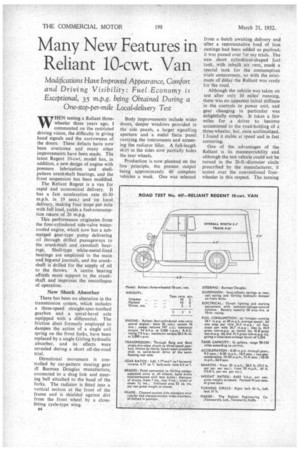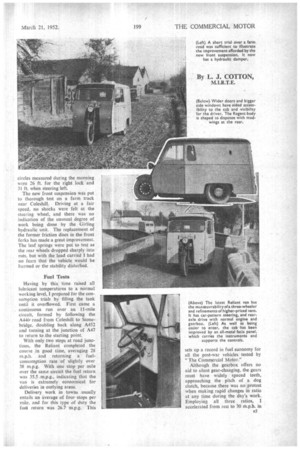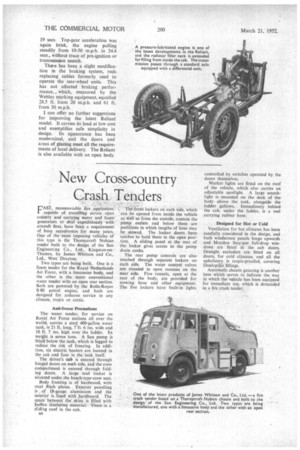Many New Features in Reliant 10-cwt. Van
Page 38

Page 39

Page 40

If you've noticed an error in this article please click here to report it so we can fix it.
Modifications Have Improved Appearance, Comfort and Driving Visibility: Fuel Economy is Exceptional, 35 m.p.g. being Obtained During a One-stop-per-mile Local-delivery Test
By L. J. COTTON,
WHEN testing a Reliant threewheeler three years ago, I commented on the restricted driving vision, the difficulty in giving hand signals and the narrowness of the doors. These defects have now been overcome and many other improvements have been made. The latest Regent 10-cwt. model has, in addition, a new design of engine with pressure lubrication and shellpattern crankshaft bearings, and the front suspension has been modified.
The Reliant Regent is a van for rapid and economical delivery. It has a fast acceleration rate (0-30 m.p.h. in 19 secs.) and on local delivery, making four stops per mile with full load, yields a fuel-consumption return of 26 m.p.g.
This performance originates from the four-cylindered side-valve watercooled engine, which now has a submerged gear-type pump delivering oil through drilled passageways to the crankshaft and camshaft bearings, Shell-type white-metal-lined bearings are employed in the main and big-end journals, and the crankshaft is drilled for the supply of oil to the throws. A centre bearing affords more support to the crankshaft and imprOves the smobffiness of operation. .
New Shock Absorber There has been no alteration in the transmission system, which includes a three-speed straight-spur-toothed gearbox and a spiral-bevel axle equipped with a differential. The friction discs formerly employed to dampen the action of a single coil spring on the front forks, have been replaced by a single Girling hydraulic absorber, and its . effects were revealed during a short off-the-road trial.
Directional movement is controlled by car-pattern steering gear df Burman Douglas manufacture, connected to a drag link and steering ball attached to the head of the forks. The radiator is fitted into a vertical section at the front of the frame and is shielded against dirt from the front wheel by a closefitting cycle-type wing. Body improvements include wider doors, deeper windows provided in the side panels, a larger signalling aperture and a metal facia panel carrying the instruments and screening the radiator filler. A full-length skirt at the sides now partially hides the rear wheels.
Production is now planned on the line principle, the present output being approximately 40 complete vehicles a week. One was selected
from a batch awaiting delivery and .after a representative load of iron castings had been added as payload, it was passed over for my trials. The new short cylindrical-shaped fuel tank, with inbuilt air vent, made a special tank for the consumption trials unnecessary, so with the minimum of delay the Reliant was ready for the road.
Although the vehicle was taken on test after only 10 miles' running, there was no apparent initial stiffness in the controls or power unit, and gear changing in particular was delightfully simple. It takes a few miles for a driver to become accustomed to the road-holding of a three-wheeler, but, once acclimatiAed, I found it stable at speed and in fast cornering.
One of the advantages of the Reliant is its manceuvrability andalthough the test vehicle could not be turned in the 26-ft.-diameter circle prescribed by the manufacturer, it scores over the conventional fourwheeler in this respect. The turning
circles measured during the morning were 26 ft. for the right lock and 31 ft. when steering left.
The new front suspension was put to thorough test on a farm track near Coleshill. Driving at a fair speed, no shocks were felt at the steering wheel, and there was no indication of the unusual degree of work being done by the Girling hydraulic unit. The replacement of the former friction discs in the front forks has made a great improvement. The leaf springs were put to test as the rear wheels dropped sharply into ruts, but with the load carried I had no fears that the vehicle would be harmed or the stability disturbed.
Fuel Tests Having by this time raised all lubricant temperatures to a normal working level, I prepared for the consumption trials by filling the tank until it overflowed. First came a continuous run over an 11-mile circuit, formed by following the A414& road from Coleshill to Stonebridge, doubling back along A452 and turning at the junction of A47 to return to the starting point.
With only two stops at road junctions, the Reliant completed the course in good time, averaging 28 m.p.h. and returning a fuelconsumption rate of slightly over 38 m.p.g. With one stop per mile over the sanrie circuit the fuel return was 35.5 .rn,p.g., indicating that the van is extremely economical for deliveries in outlying areas.
Delivery work in towns .usually entails an average of four stops per mile, and for this type of duty the fuel return was 26.7 m.p.g. This
sets up a record in fuel economy for all the post-war vehicles tested by "The Commercial Motor."
Although the gearbox offers no aid to silent gear-changing, the gears must have widely spaced teeth, approaching the pitch of a dog clutch, because there was no protest when making rapid changes in ratio at any time during the day's work. Employing all three ratios, I accelerated from rest to 30 m.p.h. in
19 secs. Top-gear acceleration was again brisk, the engine pulling steadily from 10-30 m.p.h. in 24.4 secs., without trace of pre-ignition or transmission snatch.
There has been a slight modification in the braking system, rods replacing cables formerly used to operate the rear-wheel units. This has not affected braking performance,, which, measured by the Webley marking equipment, equalled 28.5 ft. from 20 m.p.h. and 61 ft. from 30 m.p.h.
I can offer no further suggestions for improving the latest Reliant model. It carries its load at low cost and exemplifies safe simplicity in design. Its appearance has been modernized, and the doors and areas of glazing meet all the requirements of local delivery. The Reliant is also available with an open body.




















































































